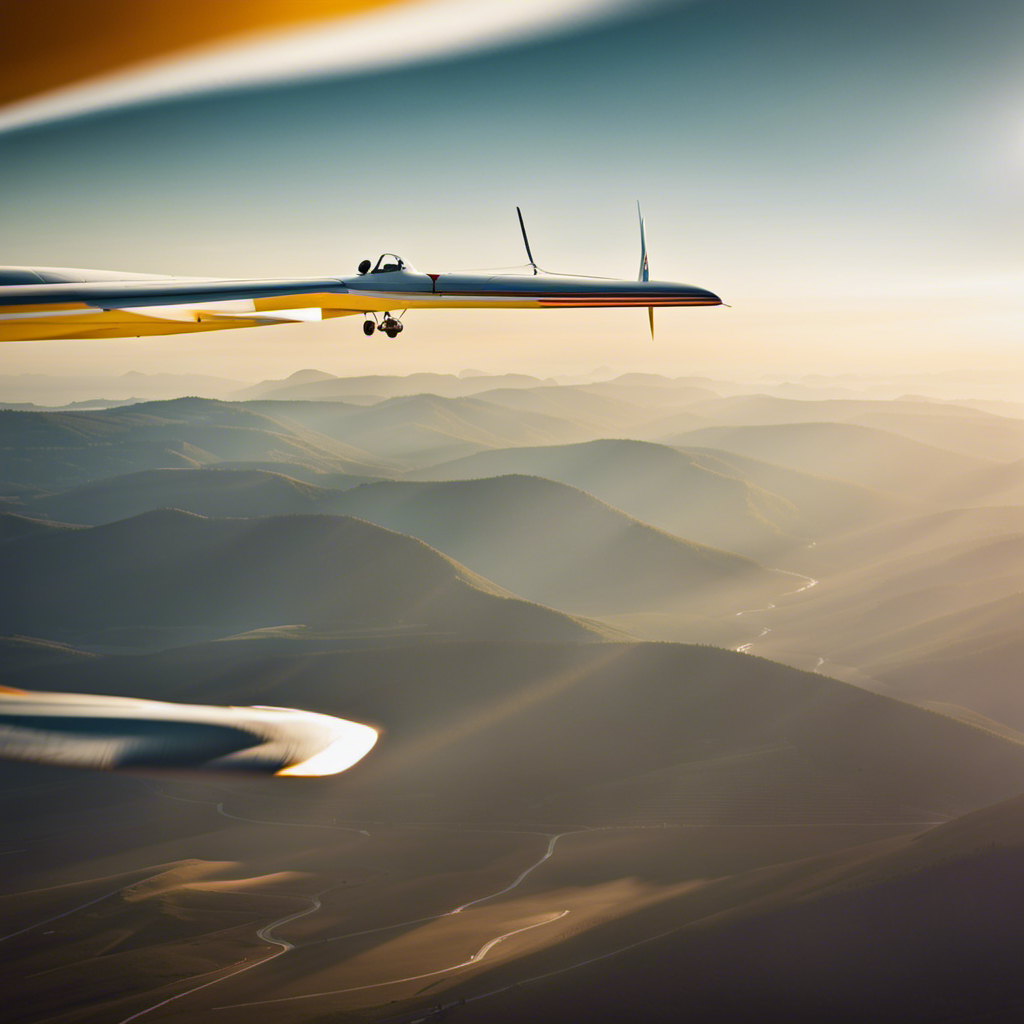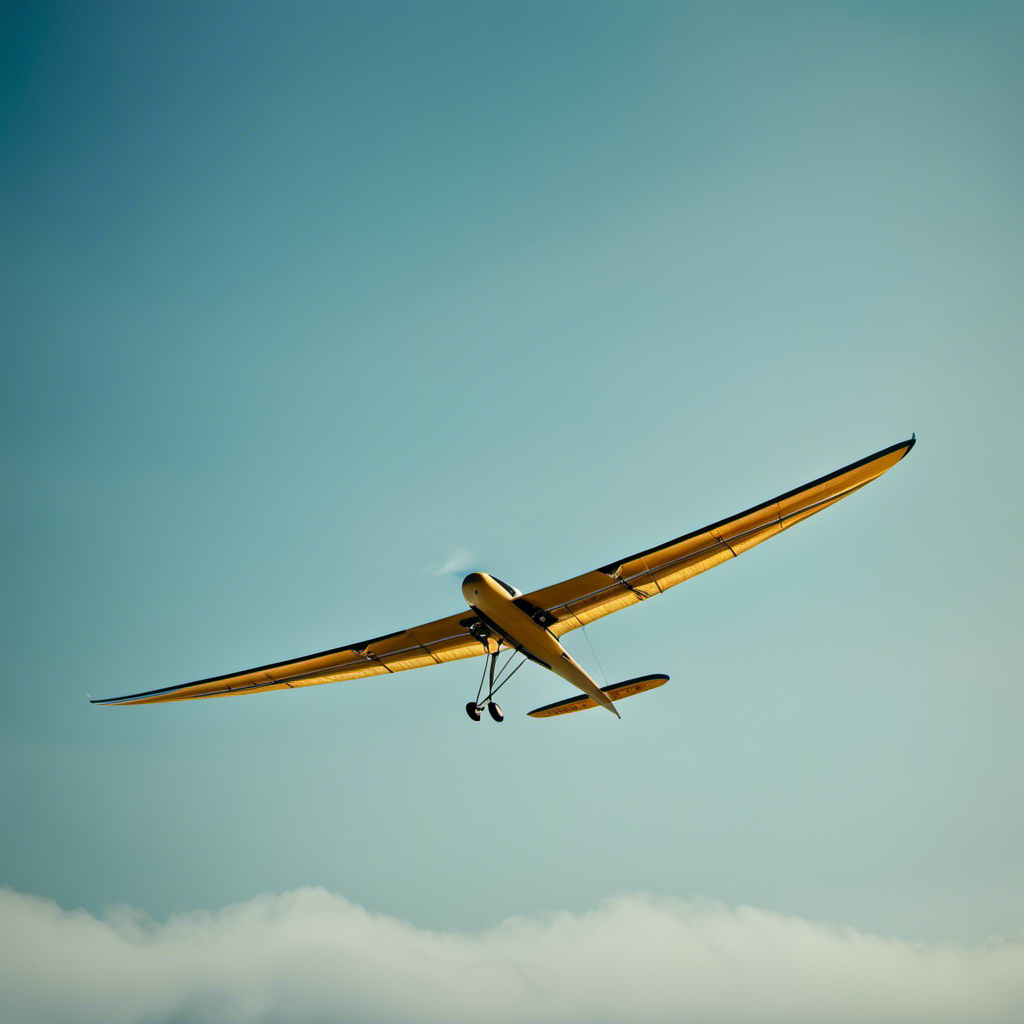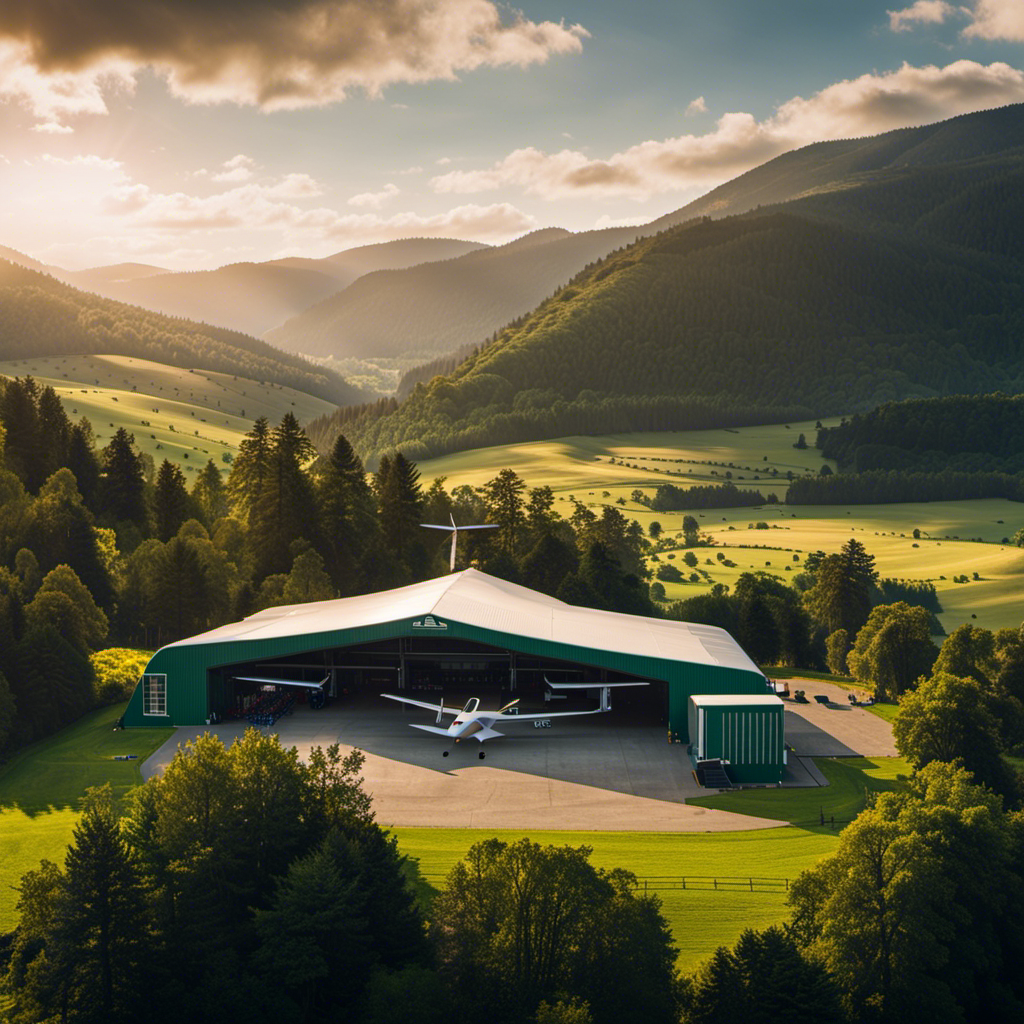Effortlessly soaring through the sky, guided by invisible air currents, thermal gliding is a captivating art form that defies gravity. As a passionate enthusiast, I have delved deep into the scientific aspects that drive this exhilarating pastime.
In this article, we will explore the intricate workings of thermals, the factors that influence soaring, and advanced techniques to master this exhilarating sport. Prepare to be astounded as we unravel the secrets and unveil the future of glider thermal soaring.
Let’s embark on this thrilling journey together.
Key Takeaways
- Gliders utilize thermal currents created by the heating of the Earth’s surface to stay aloft for extended flights.
- Understanding thermodynamics and atmospheric conditions is crucial for predicting and maximizing the use of thermals in glider soaring.
- Wind patterns, temperature variations, and the shape of the terrain all play a role in the formation, strength, and movement of thermals.
- In addition to thermals, gliders can also gain altitude using ridge lift and wave lift, which are caused by wind encountering ridges or mountains.
Overview of Glider Soaring
Glider soaring is a technique that allows gliders to take advantage of thermal currents for extended flights. Thermodynamics plays a critical role in this process, as it involves understanding the behavior of air currents and their interaction with the glider. By harnessing these natural phenomena, glider pilots can achieve remarkable distances and durations in flight.
Thermal currents are created by the heating of the Earth’s surface, causing warm air to rise and create updrafts. Gliders can exploit these updrafts to gain altitude and stay aloft for longer periods. The key is to locate areas where thermals are most likely to form, such as near sunlit slopes or over dark, heat-absorbing surfaces.
To effectively utilize these thermals, a glider pilot must have a deep understanding of the principles of thermodynamics. By analyzing the atmospheric conditions, including temperature differentials and wind patterns, pilots can predict the presence and strength of thermals. This knowledge allows them to navigate through the air currents and maximize their flight performance.
Understanding thermals is an essential skill for glider pilots, as it enables them to stay airborne and cover substantial distances. By comprehending the intricacies of thermodynamics and air currents, pilots can make informed decisions during flight, adjusting their course to remain within the thermals’ influence. This mastery of the science behind glider soaring ensures a successful and enjoyable flight experience.
Understanding Thermals
To understand thermals, you’ll need to observe the movement of air currents and feel the changes in temperature as you fly. Thermals are columns of rising air that are formed when the sun heats the ground, causing the air above it to warm up and rise. As a glider pilot, understanding thermals and wind patterns is crucial for successful thermal soaring. Here are five key points to consider:
- Thermals can be detected visually by observing the movement of clouds or by using instruments like variometers that measure changes in altitude.
- Wind patterns play a significant role in the formation and movement of thermals. Pay attention to the direction and speed of the wind to determine the best areas for finding thermals.
- Thermal soaring techniques involve circling within a thermal to gain altitude. By flying in a tight circle, you can maximize the lift provided by the thermal.
- Strategies for finding thermals include searching for areas with uneven heating, such as over dark surfaces or near sources of heat like buildings or roads.
- It is essential to anticipate the strength and size of thermals to adjust your flying techniques accordingly.
By understanding thermals and wind patterns, you can employ effective thermal soaring techniques and strategies to maximize your flight time and distance.
Now let’s delve into the next section, which focuses on lift and sustaining flight.
Lift and Sustaining Flight
As a pilot, you’ll need to understand how lift and sustaining flight work in order to stay airborne and maintain your glider’s altitude. Lift mechanics are crucial to the thermodynamics of glider flight.
Lift is the force that opposes the weight of the glider, allowing it to rise and remain airborne. It is generated by the interaction between the glider’s wings and the air flowing over them.
The key principle behind lift is Bernoulli’s principle, which states that as the speed of a fluid (in this case, air) increases, its pressure decreases. This principle explains how the curved shape of the glider’s wings, also known as airfoils, creates a pressure difference between the upper and lower surfaces. The faster airflow over the curved upper surface creates a lower pressure, while the slower airflow underneath creates a higher pressure. This pressure difference generates lift, pushing the glider upwards.
To sustain flight, the pilot must maintain a balance between lift and the glider’s weight. By adjusting the control surfaces, such as the ailerons and elevators, the pilot can control the amount of lift generated and maintain the desired altitude.
It is crucial to understand the lift mechanics and how they relate to the thermodynamics of glider flight to effectively control the glider and ensure a safe and successful flight.
Understanding the lift and sustaining flight is essential for thermal soaring. Factors such as wind patterns, temperature gradients, and terrain influence the formation of thermals, which are columns of rising air. By utilizing these thermals, pilots can gain altitude and extend their flight times.
So let’s explore the factors that influence thermal soaring and how to effectively utilize them for an optimized gliding experience.
Factors Influencing Thermal Soaring
Understanding the factors that influence thermal soaring allows me to maximize my gliding experience and gain altitude by utilizing rising columns of air called thermals. Two key factors that significantly impact thermal soaring are the influence of wind and the impact of temperature.
The influence of wind plays a crucial role in thermal soaring. Wind not only affects the formation and movement of thermals but also determines their strength and size. Wind can either enhance or disrupt thermal activity, depending on its direction and speed. When the wind is aligned with the terrain, it can create convergence zones, where thermals converge and become stronger. Conversely, when the wind opposes the terrain, it can create divergence zones, where thermals dissipate quickly.
Temperature also plays a vital role in thermal soaring. As the sun heats the Earth’s surface, it warms the air above, creating pockets of warm air called thermals. The temperature gradient between the ground and the surrounding air determines the strength and stability of these thermals. Warmer air rises and creates buoyancy, providing gliders with lift. Therefore, it is essential to monitor temperature variations and identify areas with significant temperature differentials to locate and exploit thermals effectively.
As I transition to the subsequent section about exploiting ridge lift, it is important to note that understanding the factors influencing thermal soaring lays the foundation for effectively exploiting other sources of lift, such as ridge lift.
Exploiting Ridge Lift
Ridge lift refers to the upward flowing air that occurs when wind encounters a ridge or a mountain. This phenomenon allows gliders to gain altitude without the need for thermals.
Gliders take advantage of ridge lift by flying close to the ridge, which creates a pressure difference and causes the air to rise.
The best locations for exploiting ridge lift are typically found in areas with strong and consistent winds, such as coastal regions or mountain ranges.
Definition and explanation of ridge lift
You can easily grasp the concept of ridge lift by understanding how wind interacts with the terrain.
Ridge lift refers to the upward airflow created when wind encounters a mountain or hill. As the wind approaches the ridge, it is forced to rise due to the slope of the terrain. This upward motion generates lift, allowing gliders to soar in the air.
The mechanism behind ridge lift involves the wind being deflected upwards by the slope, resulting in a region of high pressure on the windward side and low pressure on the leeward side of the ridge. This pressure difference creates an upward force that gliders can utilize to gain altitude.
Now, let’s delve into how gliders use ridge lift for soaring without relying on thermal updrafts.
How gliders use ridge lift for soaring
As wind encounters a mountain or hill, it is forced to rise due to the slope of the terrain, creating upward airflow known as ridge lift, which gliders utilize for soaring. Ridge lift is a valuable resource for glider pilots, but it requires skill and strategy to fully exploit its potential.
Here are some key points to consider:
- Importance of pilot skill in ridge soaring:
- Pilots must have a thorough understanding of the wind patterns and topography of the ridge to predict where the lift will be strongest.
- They need to make precise adjustments to their flying techniques to stay in the lift and maximize their altitude gain.
- Pilots must also be able to read subtle cues in the air, such as changes in wind direction or the presence of thermals, to optimize their flight path.
Strategies for finding and exploiting ridge lift:
- Pilots often fly along the ridge line, searching for areas where the wind hits the slope at an angle, creating stronger lift.
- They can also use ridge features, such as ridgeline gaps or convex slopes, to their advantage by focusing on these ‘hotspots’ of lift.
- Timing is crucial, as wind conditions can change throughout the day. Experienced pilots know when to start their flights to catch the best ridge lift.
By mastering these skills and strategies, pilots can make the most of ridge lift and enjoy long, exhilarating flights.
Now, let’s explore the locations with optimal ridge lift conditions.
Locations with optimal ridge lift conditions
Finding the best spots for optimal ridge lift requires careful observation and knowledge of wind patterns and topography. Identifying ridge lift locations is crucial for glider pilots seeking to maximize their soaring experience.
When searching for suitable ridge lift areas, one must consider the orientation of the ridge relative to the wind direction. A ridge perpendicular to the wind creates a lift zone, known as the ‘ridge line,’ where the air is forced to rise due to the barrier effect. Additionally, variations in terrain, such as ridges with concave shapes or irregularities, can enhance lift production.
Utilizing ridge soaring techniques, such as flying close to the ridge and maintaining a constant speed, allows pilots to take advantage of this lift.
Transitioning from ridge lift, the next topic explores the phenomenon of wave lift and its relation to mountain soaring.
Wave Lift and Mountain Soaring
When flying in mountainous regions, I always make sure to look for areas where wave lift is present. This is because wave lift can greatly maximize my glider’s soaring potential. Wave lift is a type of lift that occurs when wind encounters a mountain range, creating a series of oscillating waves in the air. These waves can extend for miles downwind, providing an excellent source of lift for gliders.
To better understand the concept of wave lift and its impact on glider soaring, let’s take a look at the following table:
| Column 1 | Column 2 | Column 3 |
|---|---|---|
| Altitude | Wind Speed | Lift Potential |
| 5000 ft | 20 knots | Moderate |
| 8000 ft | 30 knots | High |
| 10000 ft | 40 knots | Very High |
| 12000 ft | 50 knots | Extreme |
| 15000 ft | 60 knots | Maximum |
As the altitude and wind speed increase, the lift potential also increases. This means that flying at higher altitudes and in stronger winds can result in better wave lift and therefore more efficient glider soaring.
Understanding the dynamics of mountain waves and utilizing wave lift is just one aspect of glider soaring. In the next section, we will explore advanced techniques that can further enhance our soaring experience without explicitly stating ‘step’.
Advanced Techniques in Glider Soaring
Cloud streets and convergence lines are important phenomena in glider soaring. They indicate areas of lift and potential energy gain. By understanding how these features form and behave, pilots can navigate more efficiently and increase their chances of finding lift.
Dynamic soaring and speed-to-fly theory are crucial concepts. They allow glider pilots to optimize their speed and energy management in different flight conditions. This enables them to cover longer distances and achieve higher average speeds.
Cloud streets and convergence lines
As gliders ride along convergence lines, they are able to take advantage of the lift created by cloud streets. Cloud streets are formed by wind patterns that create long, narrow bands of cumulus clouds. These clouds indicate areas of rising air, which is crucial for glider pilots to stay aloft. Convergence lines occur when two air masses come together, causing the air to rise. This rising air creates lift, allowing gliders to soar effortlessly. To illustrate the importance of these phenomena, consider the following table:
| Cloud Formation | Wind Patterns |
|---|---|
| Cumulus clouds | Convergence |
| Cloud streets | Rising air |
Understanding the relationship between cloud formation and wind patterns is essential for successful glider soaring. Now, let’s explore the next section on dynamic soaring and speed-to-fly theory, where we will delve into the techniques used to optimize gliding performance without explicitly stating the transition.
Dynamic soaring and speed-to-fly theory
After learning about the fascinating phenomena of cloud streets and convergence lines, it’s time to delve into the world of dynamic soaring and speed-to-fly theory.
Dynamic soaring is a technique used by glider pilots to maximize their speed and energy efficiency by utilizing the different wind patterns at various altitudes. To effectively employ this technique, speed-to-fly techniques and energy management are crucial.
Here are five key elements to understand about dynamic soaring:
-
Speed-to-fly theory: Optimal airspeeds are calculated based on the glider’s polar curve and the current wind conditions.
-
Energy management: Pilots must carefully manage their potential and kinetic energy to maintain optimal glide performance.
-
Wind gradient effect: Utilizing the wind gradient can provide additional energy gains and help maintain speed.
-
Penetration and deceleration: Understanding the effects of wind penetration and deceleration is essential for efficient dynamic soaring.
-
Constant monitoring: Pilots must continuously monitor wind conditions and adjust their speed and altitude accordingly.
With a solid grasp of dynamic soaring techniques, we can now move on to discussing cross-country soaring strategies, which will take our soaring adventures to even greater heights.
Cross-country soaring strategies
To maximize distance covered during cross-country flights, pilots often utilize a variety of strategies and techniques.
Cross country navigation is a crucial aspect of glider flying, as it involves planning and executing a route that takes advantage of favorable wind conditions and thermal activity. By carefully analyzing weather forecasts and studying terrain features, pilots can identify areas likely to produce strong thermals, enabling them to optimize glide performance and cover greater distances.
Additionally, pilots may use techniques such as ridge soaring and wave soaring to extend their flights and explore new areas.
However, it is important to note that safety considerations play a significant role in cross-country soaring. Therefore, pilots must always remain vigilant, constantly assessing weather conditions and maintaining situational awareness to ensure a safe and successful flight.
Safety Considerations in Thermal Soaring
As a glider pilot, I understand the importance of considering safety during thermal soaring. This discussion will explore the hazards and risks associated with this type of soaring, emphasizing the need for proper pre-flight planning and weather monitoring.
Additionally, we will delve into the emergency procedures and precautions that should be followed to mitigate potential risks and ensure a safe flying experience.
Hazards and risks associated with thermal soaring
One of the hazards of thermal soaring is the risk of encountering strong crosswinds. Crosswinds can pose significant challenges for glider pilots and increase the chances of accidents. To mitigate these risks, it is essential to take certain precautions and be familiar with emergency procedures.
Here are four key hazards and risks associated with thermal soaring:
-
Turbulence: Strong thermal activity can lead to turbulent conditions, making it difficult to maintain control of the glider.
-
Wind shear: Sudden changes in wind direction and speed can create wind shear, which can cause the glider to lose lift and stability.
-
Mountain waves: When wind encounters mountains, it can create powerful waves of rising and sinking air, potentially causing the glider to be tossed around.
-
Thunderstorms: Thermal soaring near thunderstorms can be extremely dangerous due to the associated strong winds, lightning, and severe downdrafts.
Understanding and preparing for these hazards is crucial in ensuring a safe flight. By incorporating thorough pre-flight planning and diligent weather monitoring, pilots can proactively identify potential risks and make informed decisions to minimize the dangers.
Pre-flight planning and weather monitoring
After discussing the hazards and risks associated with thermal soaring, it is crucial to delve into the pre-flight planning and weather monitoring aspect of glider operations.
Before taking to the skies, thorough pre-flight preparation is essential to ensure a safe and successful flight. This involves carefully inspecting the glider for any potential issues, such as structural damage or malfunctions.
Additionally, meteorological analysis plays a pivotal role in determining the viability of a flight. By studying weather patterns, wind direction and speed, thermal activity, and cloud formations, pilots can make informed decisions regarding the timing and route of their flights. Meteorological data from sources like weather stations, radar, and satellite imagery aids in this analysis.
Understanding the current and forecasted weather conditions is crucial for optimizing flight performance and minimizing potential risks.
Transitioning into the subsequent section about emergency procedures and precautions…
Emergency procedures and precautions
Before taking off, it’s important for glider pilots to familiarize themselves with the emergency procedures and precautions to ensure their safety in case of any unforeseen circumstances.
In the event of an emergency landing, pilots should be prepared to handle the situation efficiently. This includes selecting a suitable landing site, assessing wind conditions, and initiating the proper landing techniques to minimize the risk of injury.
Additionally, knowledge of first aid procedures is crucial to provide immediate medical assistance if necessary. Pilots should be trained in basic first aid techniques such as CPR, treating burns, and immobilizing fractures.
By being well-versed in these emergency procedures and precautions, glider pilots can confidently navigate through unexpected situations and mitigate potential risks.
Looking ahead, the future of glider soaring holds exciting possibilities for enhanced safety measures and improved emergency response systems.
The Future of Glider Soaring
In discussing the future of glider soaring, it is imperative to examine the technological advancements in glider design. These advancements have greatly enhanced the performance and efficiency of these aircraft. They include the use of lightweight materials, improved wing designs, and advanced flight control systems.
Additionally, it is crucial to consider the environmental impact and sustainability of glider soaring. The sport relies on the natural energy sources of thermals and ridge lift. As glider soaring continues to gain popularity and accessibility, it is essential to explore ways to minimize its environmental footprint and ensure its long-term sustainability.
Technological advancements in glider design
You can take advantage of the latest technological advancements in glider design to enhance your soaring experience. Glider aerodynamics play a crucial role in achieving optimal performance. With innovative design features, such as sleek and streamlined shapes, gliders can minimize drag and maximize lift.
Materials innovation has also played a significant role in improving glider design. Lightweight and strong materials, such as carbon fiber composites, allow for increased maneuverability and efficiency. These advancements result in improved glider performance, allowing pilots to soar for longer durations and reach higher altitudes.
As we explore the topic of environmental impact and sustainability, it is important to consider how these technological advancements can contribute to reducing carbon emissions and promoting a greener future for glider soaring.
Environmental impact and sustainability
The advancements in glider design have led to a more environmentally friendly and sustainable soaring experience. With a focus on renewable energy and reducing carbon footprint, gliders now incorporate innovative technologies that harness the power of nature. By utilizing thermal currents and updrafts, gliders can soar effortlessly without the need for fossil fuels. This not only reduces the environmental impact but also promotes a more sustainable approach to aviation.
To highlight the impact of these advancements, consider the following table:
| Advancements in Glider Design | Environmental Benefits |
|---|---|
| Use of lightweight materials | Reduced energy consumption |
| Improved aerodynamics | Lower carbon emissions |
| Integration of solar panels | Renewable energy source |
As the popularity and accessibility of glider soaring continues to grow, these environmental considerations are becoming increasingly important. Pilots and enthusiasts are embracing the sustainable aspect of glider flying, making it a preferred choice for those who want to minimize their impact on the environment.
Growing popularity and accessibility of glider soaring
As more people discover the thrill of glider soaring, its popularity continues to rise, making it an accessible and exciting activity for all. The growing accessibility of glider soaring is due to advancements in technology and increased availability of training programs.
Glider clubs and schools are now more widespread, offering courses for enthusiasts of all skill levels. This has allowed more individuals to experience the unique sensation of flying without an engine. The benefits of glider soaring are numerous, including the opportunity to connect with nature, improve piloting skills, and experience the freedom of flight.
However, there are also drawbacks to consider, such as the significant financial investment required for purchasing and maintaining a glider. Despite these challenges, the increasing accessibility of glider soaring provides an exhilarating and rewarding experience for those who are passionate about aviation.
Conclusion and Resources
In conclusion, there are many resources available for further exploration of the science behind glider thermal soaring. Glider pilots can benefit greatly from these resources as they provide valuable information and insights into the mechanics of thermal soaring.
One such resource is the Glider Pilot’s Handbook, which offers in-depth explanations of the principles behind thermal soaring and provides practical tips for maximizing performance. Additionally, online forums and discussion boards are excellent resources for pilots to exchange knowledge and experiences related to thermal soaring. These platforms allow pilots to ask questions, share techniques, and learn from each other’s successes and failures.
Furthermore, glider clubs and associations often organize workshops and seminars dedicated to the science of thermal soaring. These events feature expert speakers who delve into the intricacies of thermals, weather patterns, and other factors that contribute to successful soaring flights. Attending these events can be highly beneficial for glider pilots looking to deepen their understanding of the science behind thermal soaring.
Lastly, scientific journals and publications focused on glider soaring and related disciplines are valuable resources for those interested in exploring the science in more detail. These publications cover topics such as meteorology, aerodynamics, and flight planning, providing pilots with a wealth of knowledge to enhance their thermal soaring skills.
To truly master the art of thermal soaring, it is crucial to tap into these resources and continuously expand one’s understanding of the science behind it. By doing so, glider pilots can reap the full benefits of thermal soaring and take their flying skills to new heights.
Frequently Asked Questions
What are the different types of gliders used for thermal soaring?
There are several types of gliders used for thermal soaring, each with its own advantages. These include sailplanes, hang gliders, and paragliders. Each type offers different flight characteristics and performance capabilities for optimal thermal soaring.
Can gliders fly at night using thermal uplift?
No, gliders cannot fly at night using thermal uplift. Nighttime thermalling, or nocturnal soaring, relies on the sun’s energy to heat the ground and create thermals. Without this energy source, thermal uplift is not available.
How do gliders navigate and find thermals?
To maximize time in thermals, glider navigation involves techniques such as circling and searching for areas of rising air. Thermals form due to temperature differences and are influenced by factors like wind, topography, and solar radiation.
Are there any specific weather conditions required for thermal soaring?
Weather patterns and atmospheric dynamics play a crucial role in thermal soaring. By investigating the truth of this theory, we can visually represent the idea that specific weather conditions are indeed required for successful glider thermal soaring.
What are the limitations of glider thermal soaring in terms of distance and duration of flight?
The limitations of glider thermal soaring in terms of distance and duration of flight are influenced by weather conditions. Strong winds, lack of thermals, and unfavorable atmospheric stability can significantly reduce both distance and duration of flight.
Conclusion
In conclusion, glider soaring is a captivating sport that relies on the intricate dance between gliders and thermals. Through careful observation and skillful piloting, glider pilots are able to harness the invisible currents of rising warm air to gain altitude and sustain flight.
Like a graceful bird riding the currents of wind, gliders gracefully navigate the sky, propelled by the power of thermals.
As technology continues to advance, the future of glider soaring looks bright, promising even more thrilling adventures for those who dare to take to the skies.
With a heart that soars as high as the skies, Aria, affectionately known as “Skylark,” is the driving force behind Soaring Skyways. Her journey into the gliding world began as a young dreamer gazing up at the soaring birds, yearning to experience the weightlessness and freedom they embodied. With years of experience both in the cockpit and behind the scenes, Aria’s commitment to the gliding community is unwavering.










